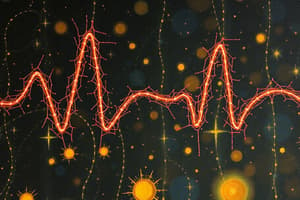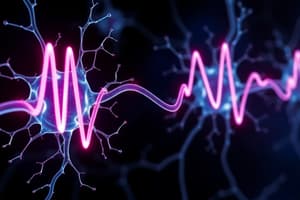Podcast
Questions and Answers
What is the primary function of ion channels in neurons?
What is the primary function of ion channels in neurons?
- To synthesize neurotransmitters for synaptic communication.
- To maintain the resting membrane potential by actively pumping ions.
- To provide structural support to the cell membrane.
- To facilitate the rapid transmission of electrical signals. (correct)
Which process best describes the change in membrane potential during depolarization?
Which process best describes the change in membrane potential during depolarization?
- A rapid increase in membrane potential due to sodium ions entering the cell. (correct)
- A return to the resting membrane potential following an action potential.
- A change in membrane potential causing it to become more negative than at rest.
- A decrease in membrane potential due to potassium ions exiting the cell.
What is the resting membrane potential of a neuron primarily caused by?
What is the resting membrane potential of a neuron primarily caused by?
- The presence of myelin sheaths along the axon.
- The activity of neurotransmitters binding to postsynaptic receptors.
- An equal distribution of sodium and potassium ions inside and outside the cell.
- An uneven distribution of ions, with more sodium outside and more potassium inside the cell. (correct)
What is a key difference between continuous and saltatory conduction?
What is a key difference between continuous and saltatory conduction?
Which of the following best describes the concept of permeability in the context of a cell membrane?
Which of the following best describes the concept of permeability in the context of a cell membrane?
What is the outcome when a neuron’s membrane potential reaches its threshold?
What is the outcome when a neuron’s membrane potential reaches its threshold?
What is the main characteristic of the Golgi stain as used by Ramon y Cajal?
What is the main characteristic of the Golgi stain as used by Ramon y Cajal?
What is the physiological effect during repolarization?
What is the physiological effect during repolarization?
Which of the following is NOT a characteristic of a stereotypical neuron as described in the text?
Which of the following is NOT a characteristic of a stereotypical neuron as described in the text?
What is the primary reason for inserting a microelectrode into a neuron?
What is the primary reason for inserting a microelectrode into a neuron?
What is the state of ion concentration in a neuron at rest?
What is the state of ion concentration in a neuron at rest?
The sodium-potassium pump of a neuron helps establish action potentials by?
The sodium-potassium pump of a neuron helps establish action potentials by?
How does the influx of sodium (Na+) ions at one location of an axon lead to an action potential at adjacent locations?
How does the influx of sodium (Na+) ions at one location of an axon lead to an action potential at adjacent locations?
What is the role of the nodes of Ranvier in myelinated axons during action potential propagation?
What is the role of the nodes of Ranvier in myelinated axons during action potential propagation?
Why does the current flow back up the axon not trigger an action potential at the original node of Ranvier?
Why does the current flow back up the axon not trigger an action potential at the original node of Ranvier?
What factor(s) increase the conduction velocity of action potentials?
What factor(s) increase the conduction velocity of action potentials?
Flashcards
Conductance
Conductance
The process of transmitting an electrical signal along the length of a neuron's axon. This occurs when an action potential is fired.
Permeability
Permeability
The ability of a cell membrane to allow certain molecules to pass through it.
Ion Channel
Ion Channel
A protein embedded in a cell membrane that allows specific ions to pass through. They are responsible for the transmission of electrical signals in the nervous system. They are fast-acting and selective.
Resting Membrane Potential
Resting Membrane Potential
Signup and view all the flashcards
Action Potential
Action Potential
Signup and view all the flashcards
Action potential Threshold
Action potential Threshold
Signup and view all the flashcards
EPSP (Excitatory Postsynaptic Potential)
EPSP (Excitatory Postsynaptic Potential)
Signup and view all the flashcards
IPSP (Inhibitory Postsynaptic Potential)
IPSP (Inhibitory Postsynaptic Potential)
Signup and view all the flashcards
Neuron
Neuron
Signup and view all the flashcards
Axon
Axon
Signup and view all the flashcards
Dendrite
Dendrite
Signup and view all the flashcards
Synapse
Synapse
Signup and view all the flashcards
Resting Potential
Resting Potential
Signup and view all the flashcards
Myelin Sheath
Myelin Sheath
Signup and view all the flashcards
Neural Integration
Neural Integration
Signup and view all the flashcards
Study Notes
Key Terms
- Conductance: The process of transmitting an electrical signal along a neuron's axon, triggered by an action potential.
- Permeability: A cell membrane's ability to allow certain molecules to pass through.
- Ion channel: A protein embedded in a cell membrane that allows specific ions to pass through, crucial for transmitting electrical signals.
Action Potential
- Action Potential: An electrical impulse that travels along an axon to transmit signals.
- Depolarization: A phase where sodium channels open, leading to a rapid increase in membrane potential, becoming more positive.
- Repolarization: A phase where potassium channels open, causing a return to the resting membrane potential.
- Hyperpolarization: A phase where the membrane potential becomes more negative than the resting potential.
- Threshold: The membrane potential level (electrical activity level) that must be reached to initiate an action potential. It's an "all-or-none" phenomenon.
Ion Distribution
- Ion distribution: Uneven distribution of ions (sodium, calcium, chloride, potassium) across the membrane is essential for creating a resting membrane potential.
- Resting membrane potential: The electrical charge difference across a neuron's membrane when it's not actively sending signals, typically around -70mV.
Action Potential Propagation
- Continuous Conduction: Slow propagation of action potentials along unmyelinated axons.
- Saltatory Conduction: Rapid transmission of action potentials along myelinated axons, "jumping" between nodes of Ranvier.
- Myelin sheath: Insulating layer around some axons, increasing the speed of action potential propagation.
- Nodes of Ranvier: Gaps in the myelin sheath where action potentials are regenerated, crucial for saltatory conduction.
Neuron Function
- Neurons: Discrete cells, transmitting signals through electrical and chemical processes.
- Neurotransmitters: Chemical messengers enabling communication between neurons.
- EPSPs (Excitatory Postsynaptic Potentials) are small depolarizing signals at synapses
- IPSPs (Inhibitory Postsynaptic Potentials) are small hyperpolarizing signals at synapses
- Spatial Summation: Combining simultaneous EPSPs from multiple synapses.
- Temporal Summation: Adding up EPSPs from one synapse over a short time.
Neuron Types and Function
- Neurons have varying shapes and sizes.
- Different receptors determine neuron function.
- Glutamate is a primary excitatory neurotransmitter; GABA is inhibitory.
- Coincidence detectors: neurons that fire when multiple signals reach them at the same time or very close.
Neurotransmitters
- Major Neurotransmitters: Specific neurotransmitters perform different roles in the nervous system. Examples include glutamate, GABA, dopamine, serotonin, acetylcholine
- Neuropeptides: Proteins that act as neurotransmitters and have widespread, often regulating, effects within the nervous system.
Studying That Suits You
Use AI to generate personalized quizzes and flashcards to suit your learning preferences.
Related Documents
Description
Test your understanding of the key terms and concepts related to action potentials in neuroscience. Explore terms like conductance, permeability, and the various phases of action potential from depolarization to hyperpolarization. This quiz will challenge your knowledge of neuronal signaling.





